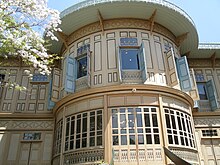Wimanmek Palace
The Wimanmek Palace ( Thai พระที่นั่ง วิมาน เมฆ , pronunciation: [ pʰráʔ tʰîː nâŋ wímaːn mêːk ], RTGS : Phra Thi Nang Wiman Mek, translated “heavenly cloud castle ”, English also Vimanmek Teak Mansion ) is a structure made entirely of teak wood Bangkok , the capital of Thailand . The building previously served as a royal residence. With its 81 rooms, it is considered the largest teak building in the world.
location
Wimanmek Palace is located in the center of Bangkok behind the old National Assembly building in the Dusit district on Ratchawithi Road. It is part of the Dusit Palace . The Wimanmek Palace is completely surrounded by canals ( khlong ) . Clockwise from the south, these are the Ang Yok ( อ่าง หยก “Jade Pond”) in the south, Khlong Rang Ngoen ( คลอง ราง เงิน ; “Silver Canal ”) in the west, the Khlong Khap Phaen Krachok ( คลอง คาบ แผ่น กระจก ; “ Glass pane canal ") In the north and the Khlong Rong Mai Hom ( คลอง ร่อง ไม้ หอม ;" Scented Wood Canal ") in the east.
Building history and use
The Wimanmek Palace was built in 1893 on the initiative of King Chulalongkorn (Rama V) on the island of Ko Sichang in the Chonburi province in the Gulf of Thailand as Phra Thi Nang Manthatrattanarot .
In 1900, Chulalongkorn had the palace building moved to its current location, which at the time was a rural area far from the old royal palace . When it was possible to move into the building again after a solemn inauguration ceremony on March 27, 1901, the king lived temporarily on the 3rd floor, while the wives and daughters were accommodated on the two lower floors. He used the building as a residence until the Phra Thi Nang Amphon Sathan (Amphon Sathan Palace) was completed in 1906 , where he stayed until his untimely death.
At the end of the reign of King Vajiravudh (Rama VI) , he let his royal wife Indrasakdi Sachi live in a part of the Wimanmek Palace, after the death of her husband she moved to the Suan Hong Residence north of the Wimanmek Palace. King Prajadhipok (Rama VII.) Had some minor renovation work carried out, for example the laying of electrical lines and the repair of the artificial lake bank at the Jade Pond. In 1935 the Wimanmek Palace was abandoned and forgotten.
In 1982, on the occasion of the 200th anniversary of the founding of Bangkok as the new capital of Siam , Queen Sirikit had the dilapidated building reconstructed and renovated so that it is now a major tourist attraction in the capital. The royal apartments on the third floor have been restored in the style of King Chulalongkorn.
architecture
The architecture of the building is in a western-influenced style, while the materials used come from Thailand. It consists of two wings arranged at right angles, both 30 meters long and 20 meters high. It is three-story and in the part where the king resided four-story. The ground floor is built with brick and cement, while the upper floors are made entirely of "golden teak". However, this wood of the teak tree is not gilded, but is so called because of its yellowish tint.
Today 31 rooms are open as a museum, some of which reflect the contemporary atmosphere of King Chulalongkorn, such as the bedrooms, the audience hall and the bathrooms. The first shower in Thailand is said to have been installed here and operated with a manual water supply to generate the necessary water pressure. Other rooms show handicrafts such as silverware, ceramics , glassware and ivory handicrafts .
literature
- Naengnoi Suksri: Palaces of Bangkok: Royal Residences of the Chakri Dynasty . Thames & Hudson Ltd., London 1996, ISBN 978-0-500-97446-9
Web links
- Presentation of the Vimanmek Palace on the website of the Bureau of the Royal Household (English, Thai) with a virtual tour
Coordinates: 13 ° 46 ′ 26 ″ N , 100 ° 30 ′ 44 ″ E


